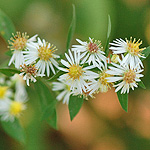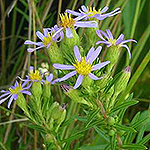
Asters in the Wild Garden.
by Eloise Butler, from Annals of the Wild Life Reserve, June 1915
Note: Since Eloise Butler's time, the scientific names of plants and the classification of plant families has undergone extensive revision. In brackets within the text, have been added when necessary, the revised scientific name for the references she used in her article. This is particularly true of the asters - all of the New World asters have been reclassified. Nomenclature is based on the latest published information from Flora of North America (Ref.#W7) and the Checklist of the Vascular Flora of Minnesota (Ref.#28C). Other information in brackets may add clarification to what she is saying.
From year to year I become more and more attached to wild asters. They are so varied in color, habit and form. They bloom from August well into October, defying frosts. The one I look at last, I like best of all, for each species has a charm peculiar to itself.
Asters indigenous to the wild garden:

Aster azureus still burgeons on the hillsides (as of October 5). It is a sine qua non not only on account of its late blossoms, but because of their profusion and bright, pure color. [Now Symphyotrichum oolentangiense var. oolentangiense; Sky Blue Aster]

Aster junceus is a pleasing adjunct of the meadows. It appears early and has a long period of bloom. The flowers, white and palely tinted, the slender stalks, and linear leaves, make it a fitting companion for its associate, the marsh bellflower, Campanula aparinoides. [Northern Bog Aster, Symphyotrichum boreale]. Photo ©Merle R. Black, Wisconsin Flora.

Aster laevis with richly colored flowers, smooth, thick leaves, and sturdy habit, is also still in evidence on dry, sandy soil. [As of her date of writing - October 5] [Smooth Blue Aster, Symphyotrichum laeve var. laeve]

“O, you cunning little thing!” we exclaim at the wee blossoms peeping out through the leaves densely clothing the diffusely branched stems of Aster lateriflorus - the so-called Calico Aster - the purple disks and pale rays forming a pattern on the background of the small green leaves. [Side-flowering Aster, Symphyotrichum lateriflorum]
Aster lateriflorus var. hirsuticaulis has somewhat larger flowers with yellow discs and seems to form a connecting link with A. tradescanti the Michaelmas daisy, which is also sparsely found in the garden. The variety has a stricter habit than the type. [This is also the "Calico Aster," Symphyotrichum lateriflorum var. lateriflorum. Note: The distinction of varieties within S. lateriflorum is not recognized today by most authorities including Flora of North America and the U of M Herbarium and MN DNR] [We believe the Aster she refers to as the Michaelmas daisy is actually the Ontario Aster, Symphyotrichum ontarionis and we illustrate that here. Today the name 'Michaelmas' is less generally applied, except for certain aster cultivars to which the nursery trade has given the Michaelmas Daisy name. These are usually purple rayed asters such as the New England Aster. The old botanical name for this aster, A. tradescanti, refers to the 17th century plant collector, John Tradescant Jr., who brought a number of the new world asters back to Europe, where the Michaelmas name got attached. Many reference sites that talk about Michaelmas Daisy rarely mention a botanical name, but one old European aster that is linked to the name is Aster amellus (Wikipedia). ]

Aster multiflorus has been largely planted in the garden, but last season I found a specimen of it well established in my swampy meadow, where I never should have thought of planting it - the inhabitant of dry prairies. This aster with its small rigid leaves and multiplicity of flowers might well be called ericoides if the name had not been preempted, for it looks like a heath. Robust specimens are fully as fine as the overworked Spirea Van Houttei. [White Heath Aster, Symphyotrichum ericoides var. ericoides] [see notes below in the "introduced" section below]

Aster novae-angliae is truly a splendid plant - tall, late-blooming, with prodigal large flowers of many shades of rich blue and pink purple. It often has the striking tone of the ironweed. [New England Aster, Symphyotrichum novae-angliae]

Aster paniculatus is often mistaken for Boltonia in the distance. The inflorescence, however, is not flat-topped like that of Boltonia, and the disk-flowers are of a deeper color. This aster is highly decorative, growing as it does in large masses. [White Panicle Aster, Symphyotrichum lanceolatum - Note: There are three varieties of this aster recognized as present in Minnesota]
Aster salicifolius has a similar habit and, when the flowers are white, is scarcely distinguished from it. [Not shown] [Willowleaf Aster or Veiny lined aster, Symphyotrichum praealtum var. praealtum]
Aster puniceus, the Red-stemmed Swamp Aster, is nearly as showy as A. novae-angliae. The typical plants, tall and bushy, their flowers with narrow rays, deep blue or pale, or even white, with orange disks, look as if studded with stars. [Symphyotrichum puniceum var. puniceum]

Aster puniceus var. lucidulus is a late bloomer and the most abundant aster in the garden, growing in large masses in the meadow bordering the west side of the tamarack bog. The stem is yellowish brown, more simple and far less hairy than that of the type. The flower is of the palest blue and somewhat smaller. The leaves are glossy and shining. [Purplestem aster, Symphyotrichum puniceum var. puniceum] [Note: The variation of A. puniceus that Eloise lists as Purplestem Aster is currently considered the same plant as Red-stemmed Aster, A. puniceus, just a variation of local ecotypes of the same plant, and the reclassification the new world asters now classifies both ecotypes as Symphyotrichum puniceum var. puniceum]

Aster sagittifolius is of refined beauty. It has a wand-like habit and is crowed with blossoms of medium size, generally white or pale blue, with purplish disks. [White Arrowleaf Aster, Symphyotrichum urophyllum]

Aster drummondii is said to be hardly distinct from it; but, with me, A. drummondii has larger, thicker leaves, larger and darker blue flowers, a less brittle stem, and a more gregarious habit. [Drummond’s aster, Symphyotrichum drummondii var. drummondii] Photo ©Mark Feider, Wisconsin Flora.

Aster umbellatus is highly esteemed because of its tallness, its ample flat-topped flower clusters of mingled gray and yellow that set off and harmonize with the luxuriant masses of Joe-Pye weed. [Flat-topped Aster, Doellingeria umbellata var. pubens]
Introduced Asters:
Aster commutatus is a sort of glorified Aster multiflorus. The flowers are quite a bit larger. I have but two roots in the garden and they have not yet blossomed. [White Prairie Aster, Symphyotrichum falcatum var. commutatum ]

Aster divaricatus sparsely introduced, has entirely died out. [White Wood Aster, Eurybia divaricata] Shown in photo.
This is also the case with Aster ericoides. Both species were obtained from Massachusetts and probably could not withstand the rigors of our severer climate. [Symphyotrichum ericoides; White Heath Aster] [This name is a misapplication. Eloise's problem with this plant is probably explained by this note from Flora of North America: "A number of aster cultivars are sold under the name 'Aster ericoides." These are all derived from European garden plants and are either cultivars of S. dumosum, S. lateriflorum, S. pilosum, or S. racemosum, or hybrids involving one of those species and another taxon. The misapplication of the epithet ericoides dates back to the nineteenth century and has persisted in the horticultural literature."

The large, rough basal leaves of Aster macrophyllus give the plant a marked individuality. The flowers, though pale in color, attract attention by their size and abundance. This aster is local in the vicinity of St. Paul and takes kindly to cultivation. [Bigleaf Aster (Large-leaved Aster), Eurybia macrophylla] [Note: This species is considered native to Minnesota].

Aster novi-belgii is not yet well established in the garden. I am not very familiar with its characteristics. [New York Aster, Symphyotrichum novi-belgii var. novi-belgii] [Note: Not native to Minnesota] Photo ©Robert Mohlenbrock, USDA-NRCS Plants Database.

Aster oblongifolius is local on our prairies. it is pleasing by reason of the size, color and aromatic odor of the blossoms. [Aromatic Aster, Symphyotrichum oblongifolium]
Aster patens did not put in an appearance this season. A particularly fine aster, its stems thickly clothed with sessile, cordate [heart-shaped] leaves, the flowers large and of rich purple hue. [Late Purple Aster, Symphyotrichum patens var. patens] [Note: Not native to Minnesota - not shown]

Aster ptarmicoides behaves like a biennial. I think every other year that it has petered out, but it comes up serenely the next season. The small flowers have the pure whiteness and texture of camellias. [Prairie Goldenrod, Oligoneuron album] [Note: Not native to Minnesota] Photo ©Christopher Noll, Wisconsin Flora.

If I have any special favorite, it is Aster sericeus The flowers are lilac tinted, a shade peculiar to themselves, and the contrast with the silky, pale foliage is altogether charming. It is abundant on the hillsides just outside of the garden and I have introduced it in large quantities. [Silky Aster, Western Silver Aster, Symphyotrichum sericeum].

Aster cordifolius is abundant in the woods along our river banks. I have specimens of remarkable beauty where I have planted it in burnt-over tracts, branching diffusely and crowded with pale blue flowers whose disks take on a richer tone in maturity. [Heart-leaved Aster, Common Blue Wood Aster, Symphyotrichum cordifolium]
Aster undulatus, also introduced from Massachusetts, perhaps on account of its thick epidermis, thrives well in the garden. Its flowers are pleasing and about of the same tone as those of A cordifolius. [Wavy-leaf aster, Symphyotrichum undulatum] [Note: Not native to Minnesota- not shown]

I would like to exchange roots of asters, if agreeable to any members of the chapter [see note at bottom of page]. I wish to experiment again with my failures and would like some specimens also of: Aster shortii [Short’s Aster, Symphyotrichum shortii, native][photo]
A. dumsous [Rice-button Aster, Symphyotrichum dumosum, many varieties, not known which, not native.]
A. vimineus [Small white oldfield aster, Symphyotrichum racemosum. not native]
A. polyphyllus [Pringle’s Aster, Symphyotrichum pilosum var. pringlei] native.
A. modestus [Giant Mountain Aster, Canadanthus modestus] native
A. angustus [Not found - name not resolved]
[Ed. note: She was evidently not successful with this request as it was 1921 until she found most of these plants - 1926 in case of Short's Aster and never in the case of the unresolved A. angustus and polyphyllus.

I find that I have omitted from my list of introduced species, A. linariifolius They have not yet reached the blossoming stage. [Stiff Aster, Flaxleaf Whitetop Aster, Ionactis linariifolius] [Note: Not native to Minnesota] Photo ©Merle R. Black, Wisconsin Flora.
Note: Most asters pictured in this article have an information sheet, with photos and descriptions, posted on this website. Use the link on the name or these links to locate them: Common Name List - Scientific Name List.